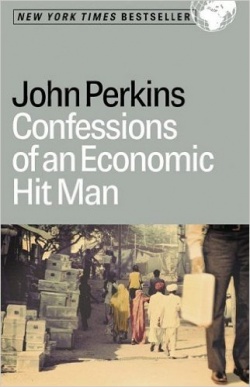Difference between revisions of "Confessions of an Economic Hit Man"
(links) |
m (tidy - important book, will need expansion) |
||
| (One intermediate revision by one other user not shown) | |||
| Line 9: | Line 9: | ||
|description=Testimony about how economies are managed by outside agencies (such as the IMF and the WB) as a form of 'crypto-colonialism'. | |description=Testimony about how economies are managed by outside agencies (such as the IMF and the WB) as a form of 'crypto-colonialism'. | ||
}} | }} | ||
| − | '''''Confessions of an Economic Hit Man''''' is a non-fiction book by [[John Perkins]]. | + | '''''Confessions of an Economic Hit Man''''' is a non-fiction book by [[John Perkins]] which spent more than 70 weeks on the ''[[New York Times]]'' bestseller list, and was published in at least 32 languages,<ref>https://www.goodreads.com/book/show/26593431-the-new-confessions-of-an-economic-hit-man</ref> and is used in many college and university programs.<ref>https://www.nytimes.com/2006/02/19/business/yourmoney/confessing-to-the-converted.html}</ref> |
==Response== | ==Response== | ||
Latest revision as of 02:30, 6 August 2021
 | |
| Type | book |
| Publication date | 2004 |
| Author(s) | John Perkins |
| ISBN | 1576753018 |
| Testimony about how economies are managed by outside agencies (such as the IMF and the WB) as a form of 'crypto-colonialism'. | |
Confessions of an Economic Hit Man is a non-fiction book by John Perkins which spent more than 70 weeks on the New York Times bestseller list, and was published in at least 32 languages,[1] and is used in many college and university programs.[2]
Response
From an article reviewing the book by Paul Craig Roberts:
The Hit Man convinces a country’s government that borrowing large sums of money from US financial institutions in order to finance the project will raise the country’s living standards. The borrower is assured that the project will increase Gross Domestic Product and tax revenues and that these increases will allow the loan to be repaid.
However, the plan is designed to over-estimate the benefits so that the indebted country cannot pay the principal and interest.
As Perkins’ puts it, the plans are based on “distorted financial analyses, inflated projections, and rigged accounting,” and if the deception doesn’t work, “threats and bribes” are used to close the deal.
The next step in the deception is the appearance of the International Monetary Fund. The IMF tells the indebted country that the IMF will save its credit rating by lending the money with which to repay the country’s creditors.
The IMF loan is not a form of aid. It merely replaces the country’s indebtedness to banks with indebtedness to the IMF.
To repay the IMF, the country has to accept an austerity plan and agree to sell national assets to private investors. Austerity means cuts in social pensions, social services, employment and wages, and the budget savings are used to repay the IMF.
Privatization means selling oil & mineral right and public infrastructure in order to repay the IMF. The deal usually imposes an agreement to vote with the US in the UN and to accept US military bases.
Occasionally a country’s leader refuses the plan or the austerity and privatization. If bribes don’t work, the US sends in the jackals – assassins who remove the obstacle to the looting process. [3]
The book proved very popular, and even prompted an official denial.[citation needed]